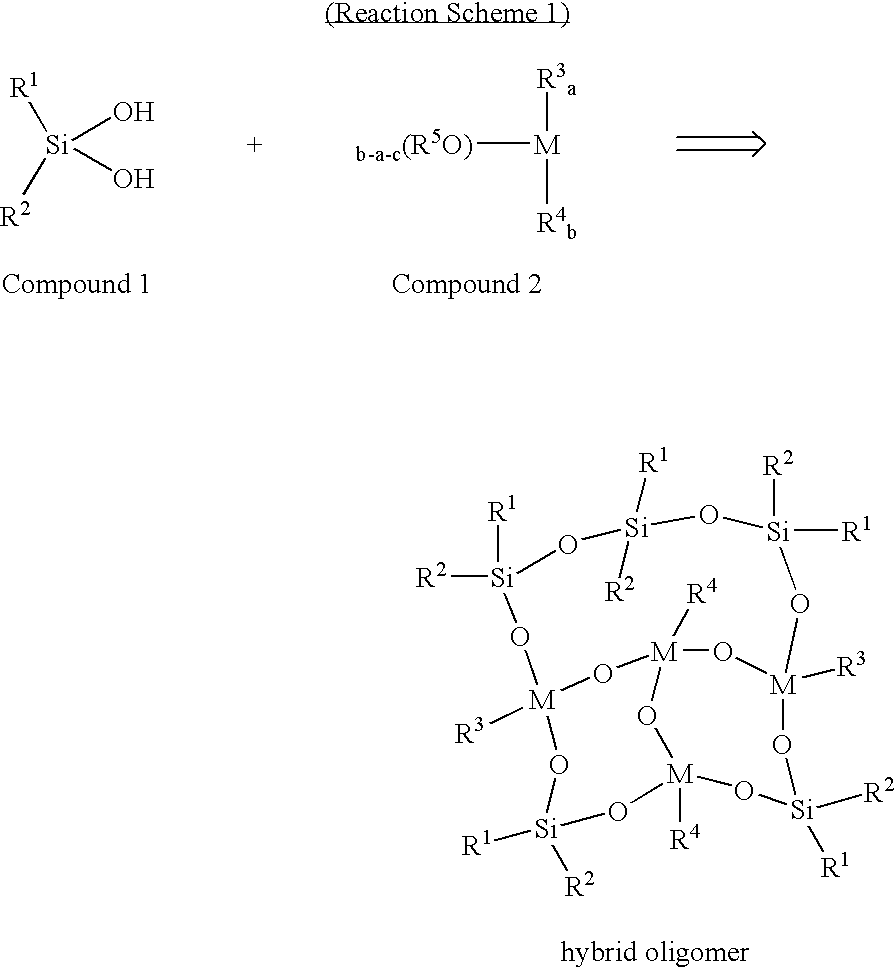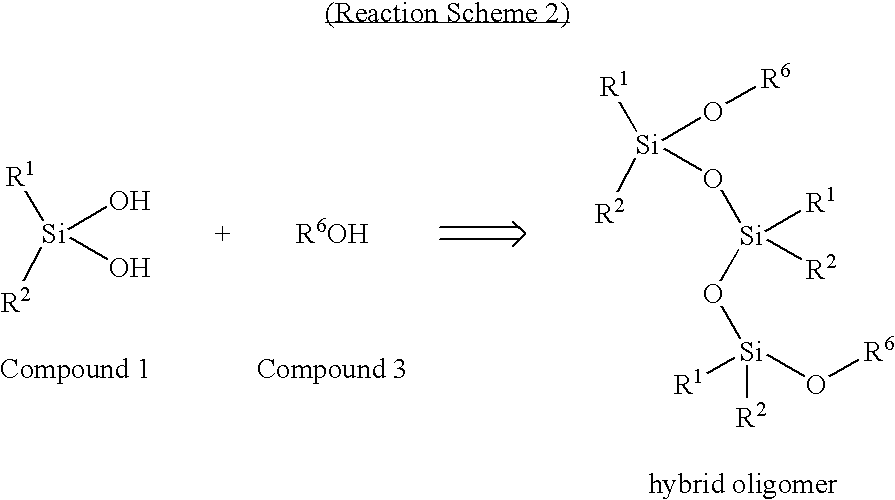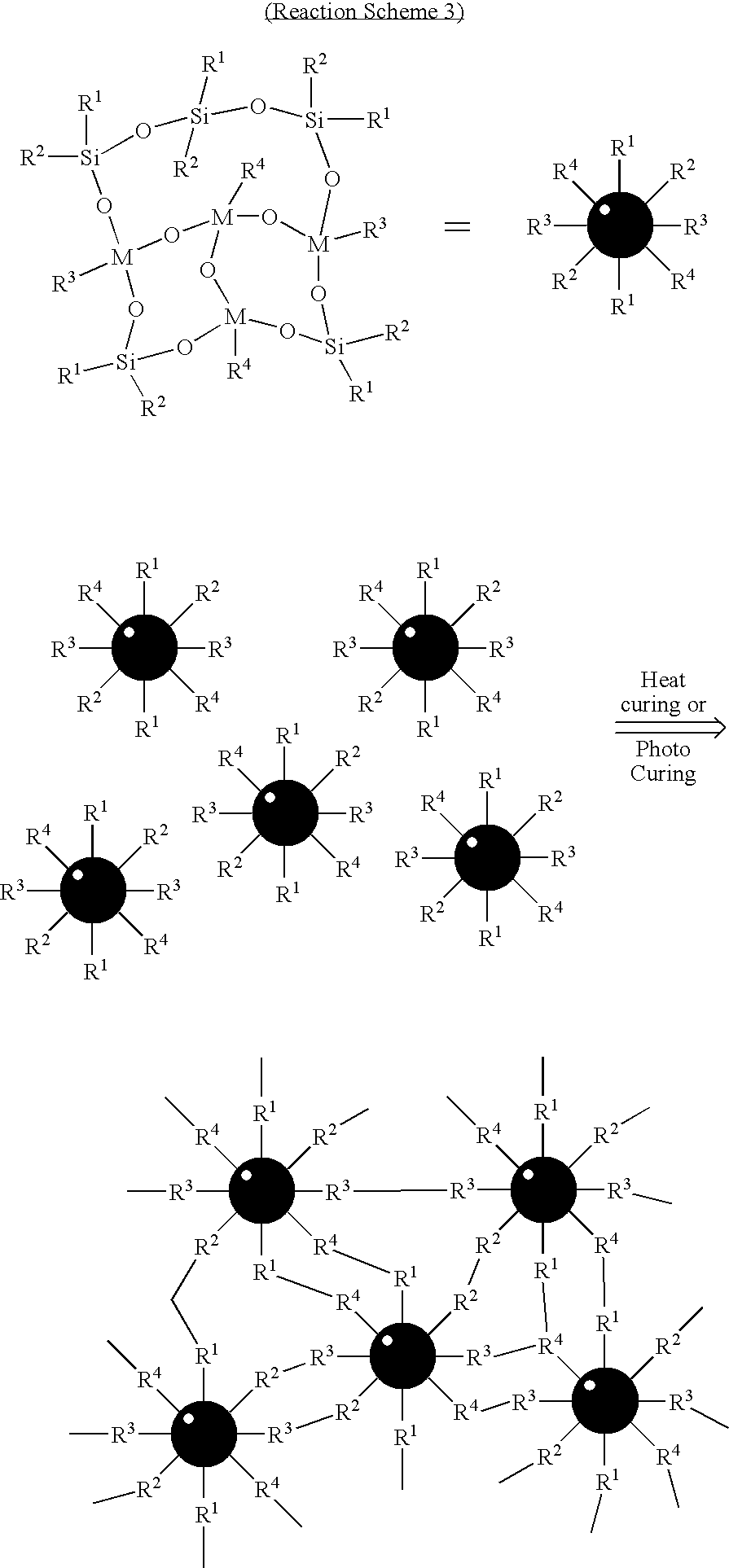Inorganic/organic hybrid oligomer and nano hybrid polymer for use in optical devices and displays, and process for preparing the same
- Summary
- Abstract
- Description
- Claims
- Application Information
AI Technical Summary
Benefits of technology
Problems solved by technology
Method used
Image
Examples
example 1
Preparation of methacryl-phenyl-silica nano hybrid polymer
[0061] 13.78 g of 3-methacryloxypropyltrimethoxysilane (Sigma-Aldrich, St. Louis, Mo.) and 12.00 g of diphenylsilanediol (Fluka, Switzerland) were mixed, and then as a catalyst to promote a siloxane reaction, 0.1 g of sodium hydroxide was added thereto. The mixture was stirred at a temperature of 80° C. for 6 hours to obtain a methacryl-phenyl-silica oligomer.
[0062] To the methacryl-phenyl-silica oligomer thus obtained was added 0.25 g of 2,2-dimethoxy-2-phenyl-acetophenone (Sigma-Aldrich, St. Louis, Mo.) as a photo initiator for acrylic curing. Thereafter, it was coated on a substrate as described in Examples 21-25 and 3 J / cm2 of UV light was irradiated on the coating using a 365 nm UV lamp and cured at a temperature of 150° C. for 4 hours to prepare a methacryl-phenyl-silica nano hybrid polymer.
example 2
Preparation of epoxy-phenyl-silica nano hybrid polymer
[0063] 13.78 g of 3-glycidoxypropyltrimethoxysilane (Sigma-Aldrich, St. Louis, Mo.) and 12.00 g of diphenylsilanediol (Fluka, Switzerland) were mixed, and then as a catalyst to promote a siloxane reaction, 0.1 g of sodium hydroxide was added thereto. The mixture was stirred at a temperature of 80° C. for 6 hours to obtain an epoxy-phenyl-silica oligomer.
[0064] To the epoxy-phenyl-silica oligomer thus obtained was added 0.25 g of 1-methylimidazole (Sigma-Aldrich, St. Louis, Mo.) as a thermal initiator for epoxy curing. Thereafter, it was coated on a substrate as described in the following Examples 21-25 and was cured at a temperature of 130° C. for 2 hours to prepare an epoxy-phenyl-silica nano hybrid polymer.
example 3
Preparation of methacryl-isobutyl-silica nano hybrid polymer
[0065] 13.11 g of 3-methacryloxypropyltrimethoxysilane (Sigma-Aldrich, St. Louis, Mo.) and 10.05 g of diisobutylsilanediol, prepared according to the method described in Mutahi et al., J. Am. Chem. Soc. 124: 7363 (2002), were mixed, and then as a catalyst to promote a siloxane reaction, 0.1 g of sodium hydroxide was added thereto. The mixture was stirred at a temperature of 80° C. for 6 hours to obtain a methacryl-isobutyl-silica oligomer.
[0066] To the methacryl-isobutyl-silica oligomer thus obtained was added 0.25 g of 2,2-dimethoxy-2-phenyl-acetophenone (Sigma-Aldrich, St. Louis, Mo.) as a photo initiator for acrylic curing. Thereafter, it was coated on a substrate as described in the following Examples 21-25 and 3 J / cm2 of UV light was irradiated on the coating using a 365 nm UV lamp and cured at a temperature of 150° C. for 4 hours to prepare a methacryl-isobutyl-silica nano hybrid polymer.
PUM
| Property | Measurement | Unit |
|---|---|---|
| Dielectric polarization enthalpy | aaaaa | aaaaa |
| Transparency | aaaaa | aaaaa |
Abstract
Description
Claims
Application Information
 Login to View More
Login to View More - R&D
- Intellectual Property
- Life Sciences
- Materials
- Tech Scout
- Unparalleled Data Quality
- Higher Quality Content
- 60% Fewer Hallucinations
Browse by: Latest US Patents, China's latest patents, Technical Efficacy Thesaurus, Application Domain, Technology Topic, Popular Technical Reports.
© 2025 PatSnap. All rights reserved.Legal|Privacy policy|Modern Slavery Act Transparency Statement|Sitemap|About US| Contact US: help@patsnap.com



